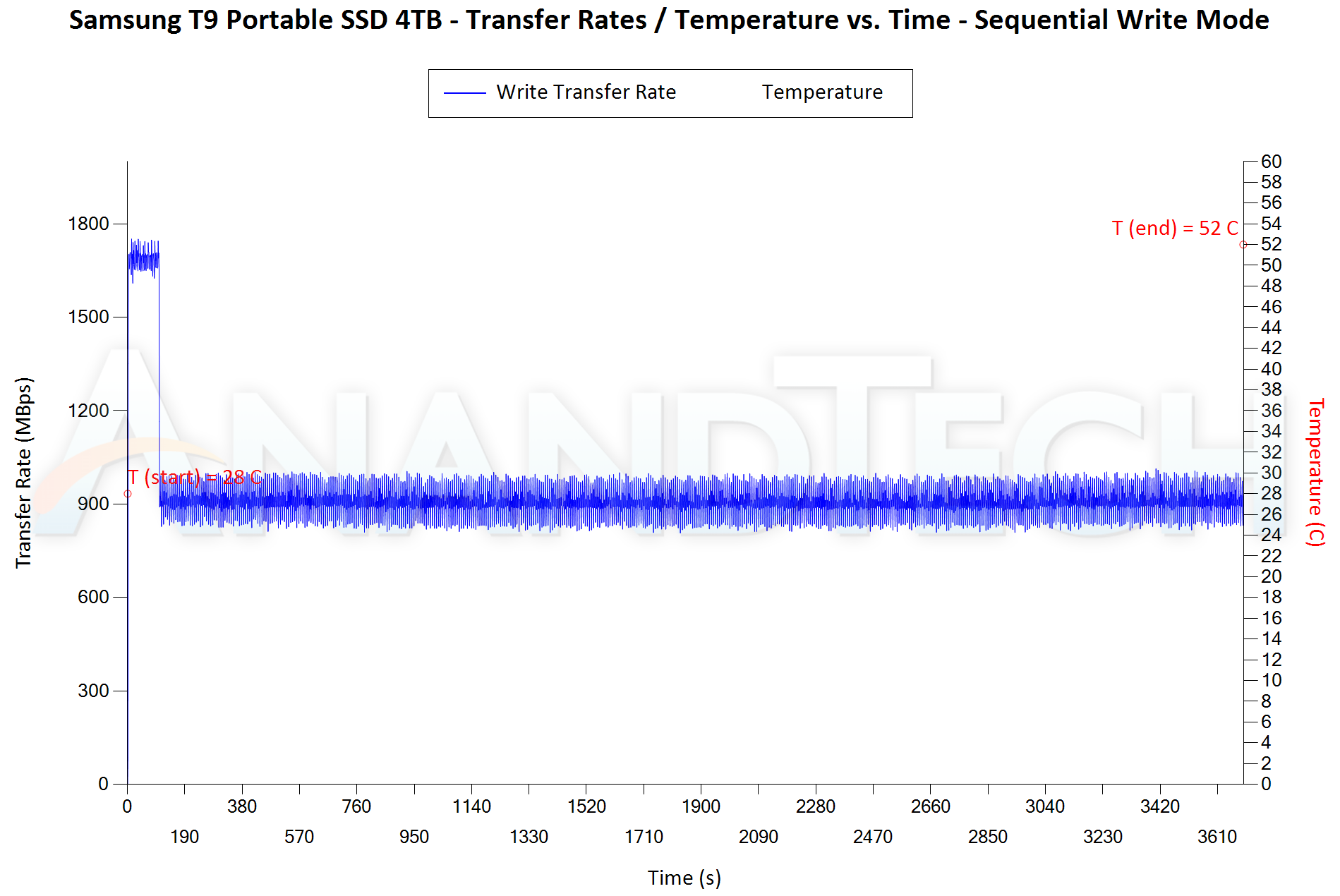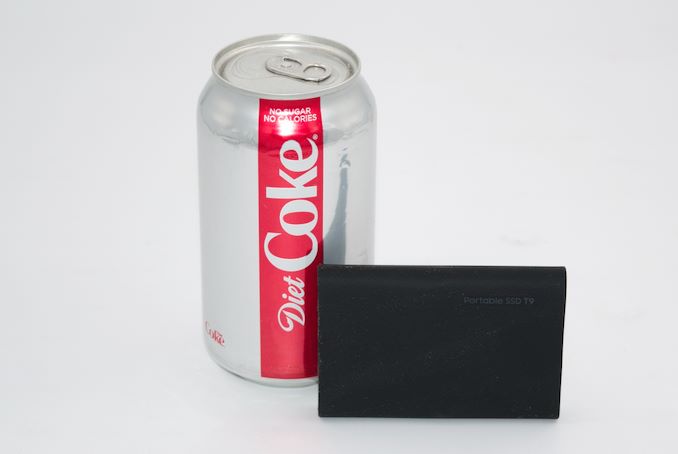Samsung T9 Portable SSD Review: A 20 Gbps PSSD for Prosumer Workloads
by Ganesh T S on October 3, 2023 10:00 AM EST- Posted in
- Storage
- SSDs
- Samsung
- External SSDs
- USB 3.2 Gen 2x2
- Portable SSDs
Miscellaneous Aspects and Concluding Remarks
The performance of the PSSDs in various real-world access traces as well as synthetic workloads was brought out in the preceding section. We also looked at the performance consistency for these cases. Power users may also be interested in performance consistency under worst-case conditions, as well as drive power consumption. The latter is also important when used with battery powered devices such as notebooks and smartphones. Pricing is also an important aspect. We analyze each of these in detail below.
Worst-Case Performance Consistency
Flash-based storage devices tend to slow down in unpredictable ways when subject to a large number of small-sized random writes. Many benchmarks use that scheme to pre-condition devices prior to the actual testing in order to get a worst-case representative number. Fortunately, such workloads are uncommon for direct-attached storage devices, where workloads are largely sequential in nature. Use of SLC caching as well as firmware caps to prevent overheating may cause drop in write speeds when a flash-based DAS device is subject to sustained sequential writes.
Our Sequential Writes Performance Consistency Test configures the device as a raw physical disk (after deleting configured volumes). A fio workload is set up to write sequential data to the raw drive with a block size of 128K and iodepth of 32 to cover 90% of the drive capacity. The internal temperature is recorded at either end of the workload, while the instantaneous write data rate and cumulative total write data amount are recorded at 1-second intervals.
| Sequential Writes to 90% Capacity - Performance Consistency | |
| TOP: | BOTTOM: |
 |
|
 |
|
The T9 is able to ingest data at the highest possible speeds for up to 105s continuously. After that, the pseudo-SLC cache of around 175 GB gets filled up, and speeds drop down to around 900 MBps. If the user workload is going to be less than 175 GB, this is not a concern at all. The thermal profile in this test is also excellent. With the temperature ending up at 52C, it is matched only by the SanDisk Extreme PRO PSSD v2's 58C, with the rest heating up to more than 65C despite having much steeper SLC cliffs. Overall, the direct-to-TLC writes could have been faster on the bandwidth front. On the thermal solution side, there is absolutely no cause for complaint.
Power Consumption
Bus-powered devices can configure themselves to operate within the power delivery constraints of the host port. While Thunderbolt ports are guaranteed to supply up to 15W for client devices, USB 2.0 ports are guaranteed to deliver only 2.5W (500mA @ 5V). In this context, it is interesting to have a fine-grained look at the power consumption profile of the various external drives. Using the ChargerLAB KM003C, the bus power consumption of the drives was tracked while processing the CrystalDiskMark workloads (separated by 5s intervals). The graphs below plot the instantaneous bus power consumption against time, while singling out the maximum and minimum power consumption numbers.
| CrystalDiskMark Workloads - Power Consumption | |
| TOP: | BOTTOM: |
 |
|
 |
|
The peak power consumption (6.7W) is quite competitive against all other PSSDs that are not based on native flash controllers. The lowest idle power number of 0.25W is also the least among such PSSDs. However, the PSSDs based on controllers like the Phison U18 and Silicon Motion SM2320 have a true deep-sleep mode where the bus power consumption is essentially non-existent. Unfortunately, the Samsung T9 doesn't seem to have such a mode.
Final Words
The Samsung Portable SSD T9 is available for purchase today, with suggested pricing of $140 for the 1 TB version, $240 for the 2 TB, and $440 for the 4 TB SKU. At these prices, the value proposition does not look good for the T9. The SanDisk Extreme PRO v2 that wins out on most of the benchmarks, and has similar thermal profile is priced at $300. We are aware that recent batches of the SanDisk PSSD have resulted in extreme consumer dissatisfaction, but we believe Western Digital has already addressed the problem if they are confident enough to continue selling it. The Crucial X10 Pro 4 TB is priced at $290, but we have not included it in the comparison list in this review, as that PSSD is still under evaluation. The other PSSDs are all based on native controllers and can't match the T9's performance profile. Despite their much lower price points, they do not contribute to the comparative value proposition discussion.
The Samsung Portable SSD T9 is a valuable addition to the company's T series lineup. It retains the sleek and attractive form-factor of its predecessors, and also adds some ruggedness with its re-designed rubber sleeve. Subjectively speaking, the new sleeve with its carbon pattern design is more functional and provides a solid feel in the hand compared to the T7 Shield.
The T9's pseudo-SLC cache size of around 175 GB is more than enough for most consumers, and likely for a large number of prosumers too. It needs to be noted that a USB 3.2 Gen 2x2 host is needed to take full benefit of the PSSD's performance. However, thanks to USB's backward compatibility, the T9 can be used with a wide variety of systems - including those with just USB 2.0 ports.
Samsung is also releasing a new version of their Magician software this month. The new version unifies the product maintenance aspect for a range of internal SSDs, memory cards, and PSSDs as well. This will also include data migration support, counterfeit checking capabilities, and the ability to set a password for the drive (and take advantage of the hardware encryption capabilities).
Compared to the Samsung X5, the T9 is able to perform reasonably well across our entire test suite. The launch pricing is a bit out of touch with market reality (given the price of the 20 Gbps PSSDs from Samsung's competitors). Pricing the T9 4 TB version around $300 would have resulted in a much better value proposition. As it stands, the performance of the T9 is passable given its DRAM-less nature. Had Samsung opted for a DRAM-equipped NVMe SSD component with the latest NAND instead of retaining the one from the T7 Shield, the T9 could have even be in the competition for the performance crown.











14 Comments
View All Comments
James5mith - Tuesday, October 3, 2023 - link
Sorry, but when do these launch? Currently no product listings except for a few sites with preorder links.Ryan Smith - Tuesday, October 3, 2023 - link
Technically it's available worldwide today. But at least in the US, you are correct. No one seems to be set to ship it before the 16th.HaninAT - Tuesday, October 3, 2023 - link
Samsung.com seems to have it and it claims to be shipping on Oct 6.https://www.samsung.com/us/computing/memory-storag...
jhoff80 - Tuesday, October 3, 2023 - link
This feels like a major cop-out in the conclusion to just recommend another drive which is known to have recent issues and then to just take the vendor's word for it that it's better now."we believe Western Digital has already addressed the problem if they are confident enough to continue selling it".
ganeshts - Tuesday, October 3, 2023 - link
A 'cop-out' would have been to not make any mention of the SanDisk external SSD problems at all while recommending it.To be frank, we have put two different 4TB SanDisk Extreme PRO v2 samples through our test suite - both were from the initial batches. One was with a firmware version that had a bug when hardware encryption was enabled - that never made it to a public release. For normal benchmarking without password protection, both drives had excellent performance and thermal profiles - as shown in the results.
If you just take a look at the different metrics, the SanDisk Extreme PRO v2 comes up short against the T9 in two aspects:
(1) pseudo-SLC cache size : 60 GB for the SD EP v2, vs. 175 GB for the T9, but if you look at the graph for the sequential write performance consistency test, writing 3.6 TB continuously to the SD EP v2 takes around 2150s, while it takes around 3700s. So, one can't say the T9 is a clear winner here.
(2) Higher power consumption - peak of 7.2W vs. 6.7W, but I will give it to the T9 here - the use of a single PCB and a DRAM-less solution is indeed more power efficient even on an average power consumption basis. The SD EP v2 uses a real M.2 NVMe SSD with DRAM for FTL in a separate board, and it does have a penalty from the energy consumption viewpoint.
I hold no torch for either WD (SanDisk) or Samsung here. I can only present analysis based on experimental results here. Unless I am going to be using the drive mainly with battery powered systems, the SD EP v2 is a better choice even from the cost perspective.
Modern-day SSDs are complex systems, and even the best vendors have had trouble with the products in this domain. Unless one goes for enterprise-focused products (that have longer validation cycles, better components, and correspondingly higher cost), there is always a risk (Even Samsung has had issues with some of their recent internal SSDs, prompting a well-known computer system assembler to drop some of those capacity points from their builds).
From a consumer viewpoint, it is always useful to follow the 3-2-1 rule. 3 copies of data in 2 different media, with at least 1 copy off-site. If you are backing up data in the field (from photo or video shoots), never delete the original contents from the card until the photos / videos have at least two other copies.
Aspernari - Friday, October 20, 2023 - link
Two whole samples! WOW. Good due diligence.> I can only present analysis based on experimental results here.
Incorrect. False. Wrong. Not true. A lie.
But you're a big part of why Anandtech has gone to hell over time, so... Keep it up?
Knowingly recommending products with known production issues is... Well. I guess that's the way stuff works here. Sort of like how Ian Cutress built this entire database of CPU performance benchmarks, in an un-airconditioned room in his home without controlling for (or measuring) ambient or CPU temperature, and just ran with it.
Or. Or. Or.
Why the hell do I keep coming back to this wasteland of a website?
Aspernari - Friday, October 20, 2023 - link
If you wanted to not cop out, you would have at least linked to another article documenting the original problem, and/or sourced a statement from the vendor. Instead, you just went with blind faith in a vendor to do the right thing. As a tech (or any other sort of) journalist, you know that's not how things work. And you know your duty doesn't stop and end at what you believe to have happened.PeachNCream - Thursday, October 5, 2023 - link
Prosumer - Thank goodness we have desperate marketing departments mashing words together to help customers feel bettwr about spending disposable income on largely frivilous electronics purchases. Sadly it works on nerd buyers quite well.Aspernari - Friday, October 20, 2023 - link
Prosumer has been used in this way for... What, 20+ years now? Welcome to 2004 or so at least.Maltz - Saturday, November 4, 2023 - link
I remember the term being in fairly common use in the 90's, and after some Googling, it was apparently coined in 1980.